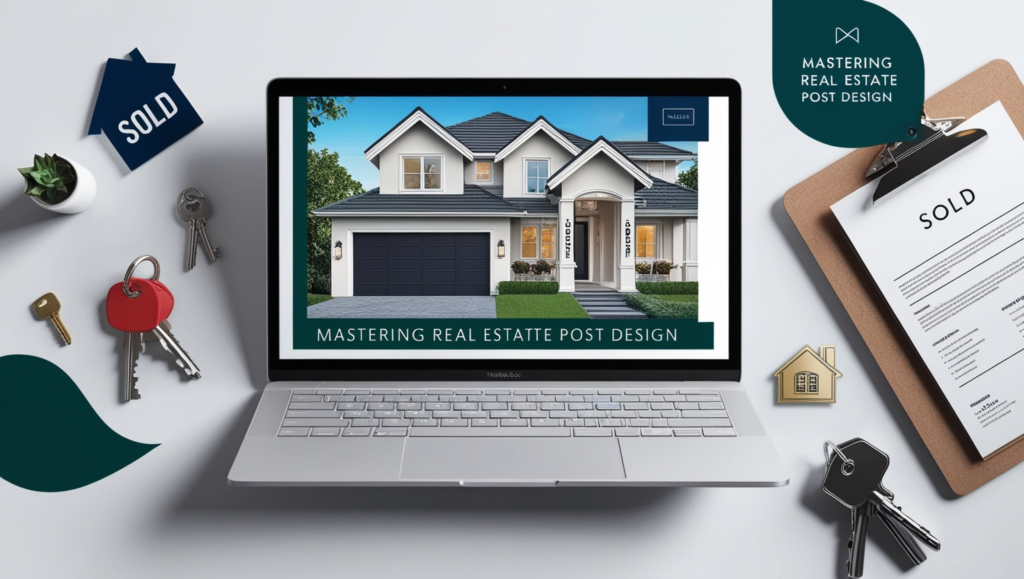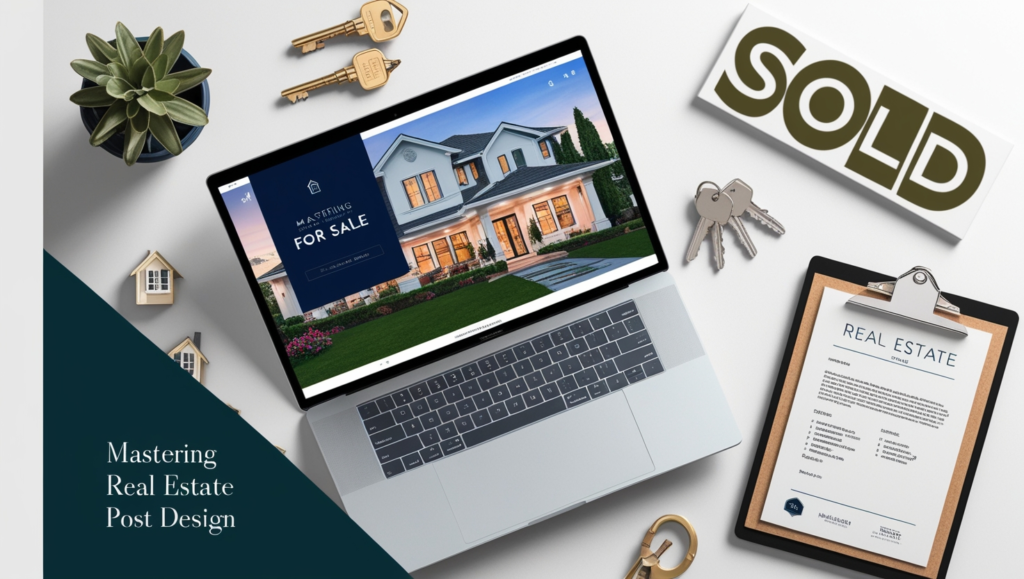In the competitive world of real estate, capturing the attention of potential buyers and sellers is crucial. One of the most effective ways to do this is through compelling real estate post design. Whether you’re showcasing a luxurious penthouse or a cozy suburban home, the way you present your properties online can make all the difference.
In this comprehensive guide, we’ll explore the ins and outs of real estate post design, providing you with the tools and knowledge to create eye-catching, informative, and persuasive property listings.
Table of Contents
The Importance of Real Estate Post Design
Real estate post design is more than just throwing together a few photos and a description. It’s an art form that combines visual appeal, strategic information placement, and persuasive copywriting. A well-designed real estate post can:
- Attract more potential buyers
- Highlight the best features of a property
- Create an emotional connection with viewers
- Increase engagement on social media platforms
- Lead to faster sales and higher offers
In today’s digital age, where first impressions are often made online, mastering real estate post design is essential for success in the industry.
Key Elements of Effective Real Estate Post Design
1. High-Quality Visuals
The cornerstone of any great real estate post design is high-quality visuals. Professional photography is a must, but don’t stop there. Consider these elements:
- Professional Photography: Hire a skilled photographer who specializes in real estate photography.
- Virtual Tours: Incorporate 360-degree virtual tours to give potential buyers an immersive experience.
- Drone Footage: For larger properties or those with impressive surroundings, aerial shots can be a game-changer.
- Video Walkthroughs: Create short, engaging video tours of the property.
Remember, your visuals are the first thing that will catch a viewer’s eye, so invest time and resources in making them spectacular.
2. Compelling Copy
While pictures may be worth a thousand words, the right words can seal the deal. Your real estate post design should include:
- Attention-Grabbing Headlines: Craft headlines that highlight unique selling points.
- Detailed Descriptions: Provide a comprehensive yet concise overview of the property’s features.
- Storytelling Elements: Help potential buyers envision themselves living in the space.
- Call-to-Action (CTA): Always include a clear CTA, such as “Schedule a Viewing” or “Contact Us for More Information.”
3. Clean and Professional Layout
The layout of your real estate post design is crucial for readability and engagement. Consider these aspects:
- White Space: Use ample white space to prevent the design from feeling cluttered.
- Consistent Branding: Incorporate your agency’s colors, fonts, and logo for a professional look.
- Mobile Optimization: Ensure your design looks great on both desktop and mobile devices.
- Logical Flow: Arrange information in a way that guides the viewer’s eye naturally through the post.
4. Key Property Information
Every real estate post design should prominently feature essential property details:
- Price: Display the price clearly, unless you’re using a “Price on Request” strategy.
- Location: Include the neighborhood, city, and any notable nearby attractions.
- Square Footage: Provide accurate measurements of the living space.
- Number of Bedrooms and Bathrooms: This is often one of the first things buyers look for.
- Unique Features: Highlight standout elements like a pool, recent renovations, or smart home technology.
5. Social Proof and Credibility
Build trust with potential buyers by incorporating:
- Agent Information: Include a photo and brief bio of the listing agent.
- Agency Credentials: Showcase any awards or recognitions your agency has received.
- Client Testimonials: Feature short, positive reviews from previous clients.

Best Practices for Real Estate Post Design
Now that we’ve covered the key elements, let’s dive into some best practices to elevate your post design:
1. Consistency Across Platforms
Your real estate post design should maintain a consistent look and feel across all platforms, whether it’s your website, social media, or print materials. This consistency helps build brand recognition and trust.
2. Use of Templates
Create templates for different types of properties or listing styles. This not only saves time but also ensures consistency in your real estate post design. However, be sure to customize each template to highlight the unique aspects of each property.
3. Seasonal Updates
Keep your real estate post design fresh by incorporating seasonal elements. For example, showcase cozy interiors during winter months or highlight outdoor spaces in the summer.
4. Infographics and Data Visualization
Incorporate infographics or charts to present data in an easily digestible format. This could include local market trends, school district ratings, or commute times to major cities.
5. Interactive Elements
Where possible, include interactive elements in your real estate post design. This could be as simple as clickable floor plans or as advanced as augmented reality features that allow viewers to virtually place furniture in rooms.
Tailoring Your Real Estate Post Design to Different Platforms
Each platform has its own quirks and best practices when it comes to real estate post design. Let’s explore how to optimize your posts for different channels:
1. Instagram
- Use a mix of high-quality photos and short video clips.
- Leverage Instagram Stories and Reels for behind-the-scenes content or quick property tours.
- Use relevant hashtags to increase discoverability.
2. Facebook
- Create albums for each property to showcase multiple photos.
- Utilize Facebook’s carousel ad format for real estate post design that allows viewers to swipe through different images.
- Take advantage of Facebook’s detailed targeting options to reach potential buyers.
3. LinkedIn
- Focus on more professional real estate post design for luxury or commercial properties.
- Share market insights and industry trends alongside property listings.
- Engage with other real estate professionals to expand your network.
4. Your Website
- Implement a responsive design that looks great on all devices.
- Include detailed property information, multiple high-resolution images, and virtual tours.
- Optimize your real estate post design for search engines (SEO) to improve visibility.
Advanced Techniques in Real Estate Post Design
To stay ahead of the competition, consider incorporating these advanced techniques into your real estate post design:
1. Artificial Intelligence (AI) and Machine Learning
Utilize AI-powered tools to:
- Automatically generate property descriptions
- Suggest optimal times to post on social media
- Predict which properties will perform best with certain demographics
2. Personalization
Tailor your real estate post design to individual viewers based on their browsing history or preferences. This could include showing similar properties they’ve viewed or highlighting features they’ve shown interest in.
3. Augmented Reality (AR)
Implement AR features in your real estate post design to allow potential buyers to:
- Visualize different furniture arrangements
- See what the property would look like with different paint colors or renovations
- Experience the property as if they were physically present
4. Voice Search Optimization
As voice search becomes more prevalent, optimize your real estate post design to include natural language that matches how people speak when searching for properties.

Measuring the Success of Your Real Estate Post Design
To continually improve your post design, it’s essential to track and analyze its performance. Here are some key metrics to consider:
- Engagement Rate: Monitor likes, comments, and shares on social media platforms.
- Click-Through Rate (CTR): Track how many people click on your listings to learn more.
- Time on Page: Measure how long visitors spend viewing your property listings.
- Lead Generation: Count the number of inquiries or showing requests generated from each post.
- Conversion Rate: Calculate the percentage of viewers who take desired actions, such as contacting an agent or scheduling a viewing.
Common Mistakes to Avoid in Real Estate Post Design
Even experienced real estate professionals can fall into common pitfalls when it comes to post design. Here are some mistakes to avoid:
- Overloading with Information: While it’s important to provide details, don’t overwhelm viewers. Keep your real estate post design clean and focused.
- Neglecting Mobile Users: With more people browsing on mobile devices, ensure your design is mobile-friendly.
- Using Low-Quality Images: Poor quality photos can make even the most luxurious properties look unappealing.
- Forgetting to Update: Outdated listings can frustrate potential buyers and damage your credibility.
- Ignoring Local SEO: Optimize your post design for local search to attract buyers in your area.
- Lack of Consistency: Maintain a consistent brand image across all your designs.
The Future of Real Estate Poster Design
Stay ahead of the curve by keeping an eye on these emerging trends:
- Virtual Reality (VR) Tours: Offer immersive property experiences from anywhere in the world.
- Blockchain for Transparency: Implement blockchain technology to provide secure and transparent property information.
- Internet of Things (IoT) Integration: Showcase smart home features and their benefits in your real estate post design.
- Sustainability Highlights: As eco-consciousness grows, emphasize energy-efficient features and sustainable materials in your listings.
Why is real estate post design important?
Real estate post design is crucial because it helps attract potential buyers, highlights property features, creates emotional connections, increases engagement on social media, and can lead to faster sales and higher offers.
How can I measure the success of my real estate post design?
Track metrics such as engagement rate, click-through rate, time on page, lead generation, and conversion rate. Use these insights to refine your design strategy over time.
What advanced techniques can I use in real estate post design?
Consider incorporating AI and machine learning for content generation and optimization, personalization based on user preferences, augmented reality features for virtual property tours, and voice search optimization.
How can I optimize my real estate post design for different platforms?
Tailor your design to each platform’s specifications. For Instagram, use high-quality images and short videos. On Facebook, create property albums and use carousel ads. For LinkedIn, focus on professional designs for luxury or commercial properties. Ensure your website has responsive design and detailed information.
What are the key elements of effective real estate post design?
The key elements include high-quality visuals (photos, virtual tours, drone footage), compelling copy, a clean and professional layout, key property information, and social proof/credibility indicators.
Conclusion
Mastering real estate post design is an ongoing process that requires creativity, technical skill, and a deep understanding of your target audience. By implementing the strategies and best practices outlined in this guide, you’ll be well on your way to creating compelling, effective property listings that stand out in a crowded market.
Remember, the key to successful real estate post design lies in striking the perfect balance between visual appeal, informative content, and strategic marketing. Continually test and refine your approach, stay up-to-date with industry trends, and always put yourself in the shoes of potential buyers.
Have you tried any of the techniques mentioned in this article? What challenges have you faced, and what successes have you achieved? Share your thoughts and insights in the comments below, and let’s continue the conversation on mastering the art of real estate post design!
